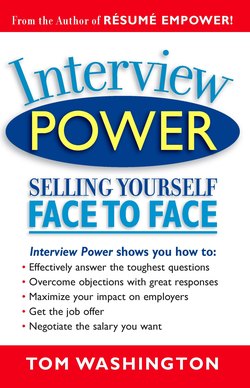Читать книгу Interview Power - Tom Washington - Страница 23
На сайте Литреса книга снята с продажи.
A Nonwork Experience With A Work Experience
ОглавлениеOne technique is to combine a nonwork experience with a work-related experience. The nonwork-related experience may be especially vivid or have a particularly useful hook in it which will help the employer remember you. A hook is any word-picture or imagery that will help a person recall a story. The nonwork experience might be selected simply because it is the best experience you have which demonstrates a certain skill. Combining the nonwork experience with a recent work experience can help create a vivid picture of you that communicates a lot about your skills and qualities. It can demonstrate that these skills and qualities are an integral part of your being, as you use the skills both on and off the job. A nonwork experience could come from volunteer work such as being a chairperson in a professional association, it could be related to a hobby, or it could come from any type of experience that is not directly associated with a job. Let’s look at an example where James answers the question, “What is your greatest strength?”
My greatest strength is my ability to take on difficult projects. I guess I just like the challenge. And people know that if I take something on, I’m going to get it done right. I’m an officer of a ski club that loves to ski at Crystal Mountain, where you have great snow and a beautiful view of Mount Rainier. We skied there often enough that we wanted to have our own lodge there. The problem was we couldn’t afford one. And if we raised the dues too high, we’d lose some of our members. After three weeks of discussing the deal, virtually everyone thought it was a dead issue. I wasn’t ready to give up, though. I studied tax codes and every angle imaginable to finance the project. Eventually I came up with a way that our more affluent members could own shares in the $500,000 project and would receive a very secure return that would be tax free. Sixteen months later we had a beautiful lodge.
Another experience happened recently. The president of my company wanted to create a totally new product. We had the engineering capability, but we had no way to finance it. After trying numerous avenues, with nothing working, I suggested trying a joint venture with a Japanese company. I had studied joint ventures that had failed as well as ones that had succeeded. When they failed it was usually because the Japanese firm would gain new technology without giving much back to the joint venture partner. I identified a Japanese firm that already had had two successful joint ventures—one with an American company and the other with a German company. They really seemed to understand the idea of win-win. I was given permission to pursue a joint venture with the firm and after nine months of negotiating, finalized a deal. One year into the joint venture, both parties are satisfied. We got the financing we needed and an open market in Japan, and our partner has obtained some very valuable technology they can use in the future.
